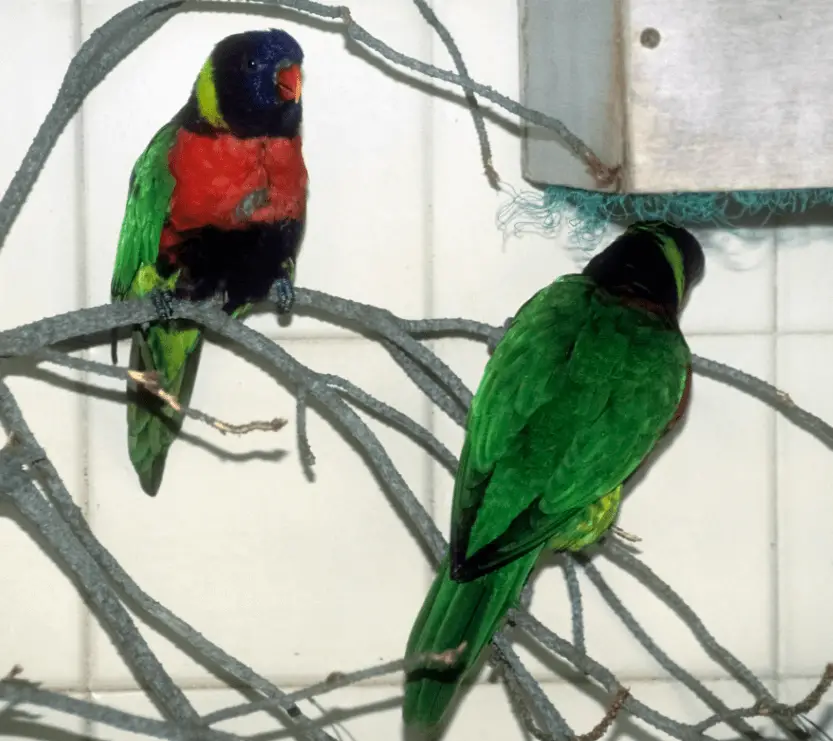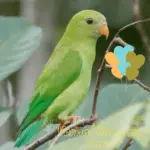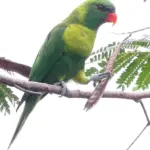an extensive dark blue patch on the central belly that extends onto the ventral region, a dark purple-blue band on the upper mantle, and mainly yellow lower flanks and under tail-coverts, with slight green barring. Sexes are alike.
Immature is duller than an adult, with a brownish-black bill and eyes (orange-red in adult), and a more pointed tail.
Race mitchellii is slightly smaller, and lacks a dark blue band on the upper mantle; race djampeanus differs from nominating only in having brighter blue streaking on the head;
race stresemanni has orange breast with virtually no dark edgings, green streaking on the rear crown, sides of belly patch suffused greener, poorly defined blue mantle band, and has yellow or orange bases to mantle feathers.
Systematics History
Editor’s Note: This article requires further editing work to merge existing content into the appropriate Subspecies sections. Please bear with us while this update takes place.

Sunset Lorikeet
With one exception, has hitherto been treated as a group of subspecies within the widespread Rainbow Lorikeet T. haematodus complex, but differs from morphologically closest forms (T. haematodus, T. Rosenberg, T. moluccanus) by various combinations involving crab-red breast (at least 2);
Subspecies
Trichoglossus forsteni mitchellii Scientific name definitions
Distribution
Trichoglossus forsteni forsteni Scientific name definitions
Distribution
Trichoglossus forsteni djampeanus Scientific name definitions
Distribution
Trichoglossus forsteni stresemanni Scientific name definitions
Distribution
Distribution
Editor’s Note: Additional distribution information for this taxon can be found in the ‘Subspecies’ article above. In the future, we will develop a range-wide distribution article.
Habitat
Most types of lowland and lower montane wooded country; tends to favor edges and disturbed vegetation rather than the interior of closed-canopy formations.
Typically from sea-level to 500–700 m, but to 2150 m on Lombok and 1200 m on Sumbawa.
Movement
Nothing known.
Diet and Foraging
No specific data, but presumably similar to T. haematodus.
Sounds and Vocal Behavior
No known differences between this species and T. haematodus.
Breeding
No information, other than birds reported in breeding condition in May on Sumbawa. Sunset Lorikeet Nests in a deep hole in a large tree.
Conservation Status
VULNERABLE. CITES II. Restricted-range species: present in Java and Bali Forests EBA and Northern Nusa Tenggara EBA. Found (at least formerly) on the islands of Bali, Lombok, Sumbawa, Tanahjampea, and Kalaotoa, Indonesia.
No robust estimate, but the population is suspected in 2016 to be 1600–7000 mature individuals, undergoing moderately rapid population declines caused by trapping for the wild bird trade.
Sunset Lorikeet, Red Lory Play Time #shorts
SOURCE: Basona Birds Bangladesh
Subspecies mitchelli rare on Bali, where possibly a recent colonizer from Lombok; although common above 1300 m in the 1910s and 1920s, repeated searches have not found the species.
On Lombok taxon, Mitchell had not been recorded for many years, until a flock of 18 was found above 1500 m on Mt Rinjani in Sep 2015.
Nominate forsteni (Sumbawa) once seasonally common on Sembalun plateau; recent sightings suggest that it is not in danger.
Weakly marked race djampeanus likely to have been trapped to near-extinction on Tanahjampea, to which it is endemic, by 1990s; now almost certainly extinct, having not been found on visits in 2011, 2013, and 2014.
Kalaotoa has not been visited by ornithologists for two decades; the most recent record of endemic subspecies Stresemann was of two heard in 1995.





















